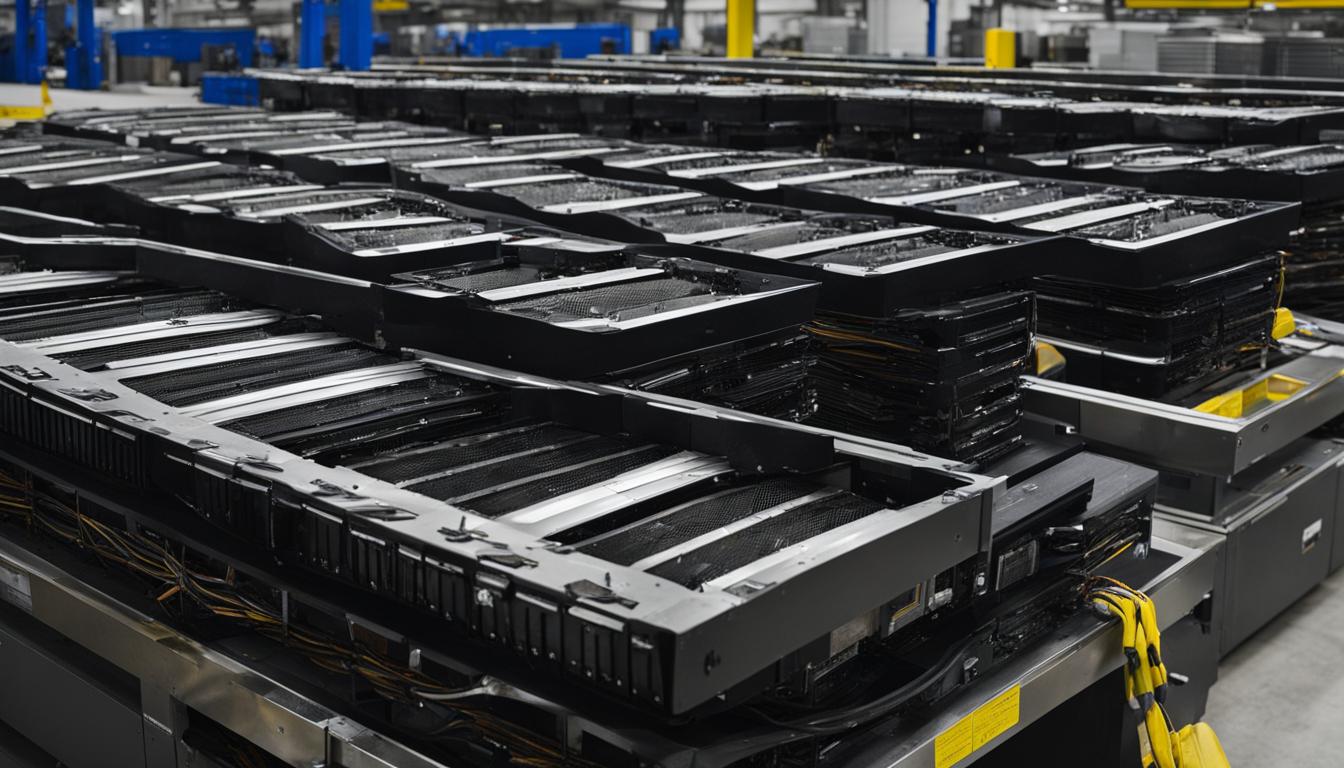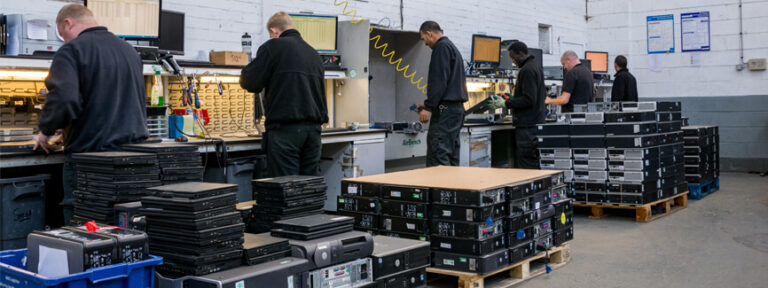Building a Sustainable Future with Server Recycling
Sustainable server recycling plays a crucial role in achieving environmental sustainability in the digital age. With a staggering amount of e-waste generated globally each year, it is essential for businesses to adopt responsible practices in recycling, refurbishing, or disposing of outdated IT hardware. By doing so, companies can minimize their carbon footprint, conserve natural resources, and meet the growing demand for sustainable technology solutions.
Key Takeaways:
- Sustainable server recycling is vital for environmental sustainability.
- Businesses should adopt responsible practices in e-waste management.
- Server recycling helps minimize the carbon footprint of IT hardware.
- Conserving natural resources is a key benefit of sustainable server recycling.
- Sustainable technology solutions are in high demand.
The Environmental Impact of E-Waste
E-waste generation is a global concern, with approximately 53.6 million metric tons of electronic waste discarded worldwide each year, according to the Global E-waste Monitor report. This staggering amount of e-waste poses significant environmental challenges that need to be addressed.
Improper disposal of electronic devices can lead to soil and water contamination due to the hazardous materials they contain, such as lead, mercury, and cadmium. These substances can cause severe harm to ecosystems and human health. It is crucial to implement sustainable server recycling practices to prevent the release of these hazardous materials into the environment.
In addition to the direct environmental impact of e-waste, the extraction of raw materials for electronic device production contributes to deforestation and loss of biodiversity. By embracing responsible recycling practices, we can minimize the need for extracting more resources, conserving natural habitats and reducing the overall environmental footprint of the IT industry.
| Hazardous Materials | Environmental Impact |
|---|---|
| Lead | Soil and water contamination, affects human health and wildlife |
| Mercury | Water pollution, bioaccumulation in aquatic organisms |
| Cadmium | Soil contamination, toxic to plants, animals, and humans |
“Proper e-waste management is crucial in preventing environmental pollution and safeguarding public health.”
The Role of IT Recycling in Sustainable Development
IT recycling is a crucial component of sustainable development, aligning with the principles of the circular economy and regenerative design. By recycling IT components, businesses can not only minimize the environmental impact of e-waste but also contribute to resource conservation and job creation in the recycling industry.
One of the key aspects of IT recycling is its ability to promote responsible consumption and production. By extending the lifespan of IT equipment through refurbishment and recycling, companies can reduce the demand for new electronic devices, thereby conserving natural resources, including raw materials and energy. This contributes to the overall goal of sustainable development by minimizing the exploitation of finite resources and reducing greenhouse gas emissions associated with the production and disposal of electronics.
The concept of a circular economy is closely tied to IT recycling. In a circular economy, products are designed with longevity and recyclability in mind. This design approach ensures that at the end of a product’s lifecycle, its components can be easily disassembled and recycled, reducing waste and promoting resource efficiency. IT recycling plays a vital role in closing the loop of the circular economy by recovering valuable materials from discarded IT equipment and reintroducing them into the production cycle.
“IT recycling is not just about waste management; it is a vital component of sustainable development.”
The Benefits of IT Recycling in Sustainable Development
IT recycling offers a range of benefits that contribute to sustainable development. Firstly, it helps to reduce the environmental impact of e-waste by diverting electronic devices from landfill and ensuring their proper disposal. This prevents hazardous materials from contaminating soil and water sources, safeguarding human health and ecosystems.
Secondly, IT recycling creates job opportunities in the recycling industry. As the demand for responsible e-waste management grows, more professionals are needed to collect, disassemble, and recycle IT equipment. This not only provides employment opportunities but also promotes economic growth and social well-being.
Lastly, IT recycling demonstrates corporate responsibility and aligns with the values of eco-conscious consumers. Companies that prioritize sustainable practices, including responsible IT disposal, enhance their brand image and attract environmentally conscious customers. This fosters customer loyalty and strengthens the company’s position in the market.
Table: Environmental Benefits of IT Recycling
| Benefits | Description |
|---|---|
| Reduces e-waste | Diverts electronic devices from landfill and prevents hazardous materials from contaminating the environment. |
| Conserves resources | Recovers valuable materials from IT equipment, reducing the need for raw material extraction and energy-intensive manufacturing processes. |
| Creates jobs | Generates employment opportunities in the recycling industry, contributing to economic growth and social well-being. |
| Enhances brand image | Demonstrates corporate responsibility and attracts eco-conscious customers, fostering customer loyalty and market competitiveness. |
By embracing IT recycling as part of their sustainability strategies, businesses can play a significant role in achieving sustainable development goals while contributing to a greener and more prosperous future.
Innovations in Sustainable Data Centre Design
The data centre industry is continuously striving to reduce its environmental impact through innovative design solutions. These innovations focus on areas such as cooling systems, energy generation, and material reuse, all with the goal of achieving greater sustainability and efficiency. By implementing these advancements, data centres can significantly contribute to reducing their carbon footprint and promoting a circular economy.
Innovative Cooling Solutions
One of the key areas of innovation in sustainable data centre design is cooling solutions. Traditional cooling methods consume significant amounts of energy, resulting in high operational costs and environmental impact. However, data centres are now adopting innovative cooling technologies that optimize energy efficiency.
Heat recovery systems, such as direct-to-chip and immersion cooling, are gaining popularity. These techniques directly dissipate heat from the source, resulting in more efficient cooling and reduced energy consumption. By minimizing the need for traditional HVAC systems, data centres can achieve substantial energy savings.
Regenerative Design
Regenerative design principles are also being embraced in sustainable data centre design. This approach focuses on restoring and renewing socio-ecological functions, aiming to create systems that have a positive impact on the environment and society.
Data centres are incorporating regenerative design by implementing green infrastructure, such as green roofs and renewable energy systems, to minimize their environmental footprint. These designs help promote biodiversity, reduce heat island effects, and improve air quality in surrounding areas.
Onsite Power Generation
Another innovative approach in sustainable data centre design is the utilization of onsite power generation technologies. By generating electricity on-site using renewable sources, data centres can reduce their reliance on traditional power grids and minimize their carbon emissions.
Green hydrogen, for example, is an emerging technology that can provide a reliable and sustainable energy source for data centres. It is produced through the electrolysis of water using renewable electricity. By adopting green hydrogen as an onsite power generation solution, data centres can achieve greater energy independence and reduce their environmental impact.
Circular Economy
Data centres are also embracing the principles of the circular economy by reusing materials and components. Instead of disposing of outdated equipment, data centres are refurbishing or repurposing them for other purposes within their facilities.
This approach not only reduces e-waste but also extends the lifespan of valuable resources. By implementing circular economy practices, data centres can contribute to resource conservation, minimize waste generation, and create a more sustainable industry.
Overall, innovations in sustainable data centre design are transforming the industry by reducing energy consumption, promoting renewable energy, and minimizing waste generation. These advancements are paving the way for a greener and more environmentally conscious digital future.

Corporate Responsibility in IT Recycling
Corporate responsibility is a key factor in driving sustainable practices in IT recycling. By adopting responsible e-waste management strategies, companies not only contribute to environmental conservation but also enjoy several advantages. One of the significant benefits is cost-saving. Implementing efficient IT recycling practices can reduce waste disposal costs, as proper disposal methods may be more economical than paying for landfill fees. Recycling also allows companies to recover valuable materials from outdated IT equipment, which can be reused or sold for profit.
Furthermore, corporate responsibility in IT recycling has a positive impact on brand image. In an era where sustainability is increasingly important to consumers, companies that prioritize green initiatives and responsible e-waste management are seen as environmentally conscious and socially responsible. This can enhance brand reputation and attract eco-conscious customers who value sustainable practices. Additionally, employees are more likely to be engaged and motivated when their employers demonstrate a commitment to corporate responsibility, including in the area of IT recycling.
“By adopting responsible e-waste management strategies, companies not only contribute to environmental conservation but also enjoy several advantages.”
“In an era where sustainability is increasingly important to consumers, companies that prioritize green initiatives and responsible e-waste management are seen as environmentally conscious and socially responsible.”
Benefits of Corporate Responsibility in IT Recycling
To summarize, corporate responsibility in IT recycling brings several benefits to companies:
- Cost-saving through efficient waste disposal methods and material recovery
- Enhanced brand image and reputation among eco-conscious consumers
- Increased employee engagement and motivation
By embracing responsible e-waste management practices, companies can make a positive impact on both the environment and their bottom line.
| Benefits of Corporate Responsibility in IT Recycling |
|---|
| Cost-saving through efficient waste disposal methods and material recovery |
| Enhanced brand image and reputation among eco-conscious consumers |
| Increased employee engagement and motivation |
Government Policies and Regulations on IT Recycling
Government policies and regulations play a crucial role in driving sustainable practices in IT recycling and promoting a circular economy. With the increasing volume of e-waste generated globally, governments worldwide have recognized the importance of implementing laws and regulations to manage electronic waste effectively. These policies aim to ensure proper disposal, reduce the environmental impact of e-waste, and encourage responsible IT recycling.
One key aspect of government policies is the requirement for manufacturers to take back their products for recycling. This enforces their responsibility in the lifecycle of electronic devices and helps prevent improper disposal. By holding manufacturers accountable, governments promote accountability throughout the supply chain, from production to disposal.
Compliance with government policies and regulations on IT recycling is essential for businesses. Failure to comply can result in fines and legal issues. It is crucial for companies to stay updated on the specific laws and regulations in their jurisdiction to ensure proper handling and disposal of e-waste. By adhering to these policies, businesses can contribute to the reduction of e-waste, protect the environment, and demonstrate their commitment to corporate responsibility.
The Impact of Government Policies and Regulations
“Government policies and regulations provide the necessary framework for sustainable IT recycling practices. They create a level playing field for businesses, ensuring that all manufacturers and organizations follow responsible e-waste management practices. By enforcing compliance, governments protect the environment, promote a circular economy, and foster innovation in the recycling industry.” – Sustainability Expert
The impact of government policies and regulations extends beyond environmental benefits. These policies also contribute to the development of a robust and sustainable IT recycling industry, creating job opportunities and driving economic growth. Businesses that comply with these regulations can gain a competitive advantage, as consumers increasingly prioritize sustainability in their purchasing decisions.
Furthermore, government policies and regulations provide a foundation for collaboration between businesses, governments, and individuals in addressing the e-waste challenge. Through partnerships and collective action, stakeholders can work together to develop innovative solutions, enhance recycling infrastructure, and promote awareness about responsible IT disposal.
The Future of Sustainable Server Recycling
As technology continues to advance at a rapid pace, the need for sustainable server recycling becomes increasingly important. With the staggering amount of e-waste being generated globally, it is crucial to explore future trends and innovations that can mitigate the impact on the environment. Sustainable server recycling not only helps reduce the carbon footprint but also promotes resource conservation and a circular economy.
One of the future trends in sustainable server recycling is the development of innovative technologies that enhance energy efficiency. This includes advancements in cooling solutions such as direct-to-chip and immersion cooling, which optimize HVAC systems and reduce energy consumption. By implementing these technologies, data centres can significantly reduce their environmental impact and lower operating costs.
“The future of sustainable server recycling holds exciting possibilities for further reducing the environmental impact of e-waste.”
In addition to energy efficiency, innovation in materials and component design plays a crucial role in sustainable server recycling. Manufacturers are exploring new ways to create longer-lasting and recyclable server components, reducing the need for frequent replacements and minimizing waste. This shift towards regenerative design principles promotes the restoration and renewal of socio-ecological functions, ensuring a more sustainable future for the industry.
Future Trends in Sustainable Server Recycling
Looking ahead, collaboration between businesses, governments, and individuals will be essential in driving sustainable server recycling practices. Companies will increasingly adopt responsible IT recycling as a standard practice, recognizing the positive impact it has on the environment, their brand image, and their bottom line. Governments will continue to play a crucial role in implementing policies and regulations that promote sustainable practices and regulate e-waste disposal. With ongoing innovation and a collective effort, the future of sustainable server recycling holds great promise for a greener and more sustainable digital future.

Data Centre Energy Efficiency Comparison
| Data Centre | Power Usage Effectiveness (PUE) | Energy Savings |
|---|---|---|
| Data Centre A | 1.8 | 20% reduction in energy consumption compared to the industry average |
| Data Centre B | 2.2 | 10% reduction in energy consumption compared to the industry average |
| Data Centre C | 1.5 | 30% reduction in energy consumption compared to the industry average |
Conclusion
Sustainable server recycling is a critical component of building a sustainable future. By adopting responsible IT recycling practices, businesses can minimise the environmental impact of e-waste, conserve natural resources, and contribute to a circular economy. Corporate responsibility plays a pivotal role in promoting and implementing sustainable server recycling initiatives, while government policies and regulations provide the necessary framework for compliance. The future of sustainable server recycling holds great potential for further advancements in energy efficiency and resource conservation, ultimately leading to a greener and more sustainable digital future.
FAQ
What is sustainable server recycling?
Sustainable server recycling refers to the responsible practices of recycling, refurbishing, or disposing of outdated IT hardware to minimize the environmental impact of e-waste and promote environmental sustainability.
Why is sustainable server recycling important?
Sustainable server recycling is important because e-waste contains hazardous materials that can contaminate soil and water if improperly disposed of. It also contributes to deforestation and loss of biodiversity through the extraction of raw materials. By recycling server components, companies can reduce their carbon footprint, conserve natural resources, and meet the demand for sustainable technology solutions.
What are the benefits of IT recycling?
IT recycling not only reduces the environmental impact of e-waste but also conserves natural resources and creates job opportunities in the recycling industry. It aligns with broader goals of environmental, social, and economic sustainability, promotes responsible consumption and production, and supports a circular economy where products are designed for longevity and recyclability.
How is the data centre industry addressing its environmental impact?
The data centre industry is implementing innovative design solutions such as direct-to-chip and immersion cooling techniques to optimize HVAC systems, embracing regenerative design principles, utilizing onsite power generation technologies, and supporting the circular economy by reusing materials and components. These efforts contribute to energy efficiency, reduced emissions, and the conservation of resources.
What role do corporations play in IT recycling?
Corporations play a crucial role in promoting IT recycling and implementing sustainable practices. By adopting responsible e-waste management strategies, companies can reduce costs, improve their brand image, engage employees in sustainability initiatives, and ensure compliance with laws and regulations. This includes setting up recycling programs, partnering with certified e-waste recyclers, and educating employees about responsible disposal.
What government policies and regulations are in place for IT recycling?
Governments worldwide have implemented laws and regulations to manage e-waste. These regulations vary by jurisdiction but generally require manufacturers to take back their products for recycling and impose penalties for improper disposal. Companies must ensure compliance with these laws to avoid fines and legal issues. Government policies and regulations are crucial in driving sustainable practices in IT recycling and promoting a circular economy.
What does the future hold for sustainable server recycling?
The future of sustainable server recycling holds exciting possibilities for further reducing the environmental impact of e-waste. Advancements in technology and innovation will continue to drive improvements in energy efficiency, resource conservation, and circular economy practices. Companies will increasingly adopt sustainable server recycling as a standard practice, recognizing the positive impact it has on the environment, their brand image, and the bottom line. Collaboration between businesses, governments, and individuals will be essential in creating a greener digital future.















